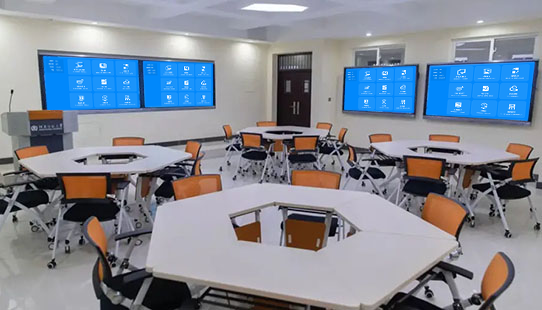Interactive Classroom Upgrade Plan: The Perfect Integration of Wireless Screen Mirroring and Group Discussions
Interactive classrooms are a key direction in the development of modern education. The organic combination of wireless screen mirroring technology and group discussion models can significantly enhance the effectiveness of teaching interaction.
1. Upgrade Path for Traditional Classrooms
Equipment Upgrade Plan
- Display device update: Replace single traditional projectors with a combination of a main screen (for whole-class teaching) and multiple split screens (for group use) to support multi-scenario display needs.
- Screen mirroring device deployment: Install independent wireless screen mirroring devices for each group, ensuring stable and interference-free content sharing within groups.
- Network environment optimization: Upgrade to a high-bandwidth, low-latency Wi-Fi network to support simultaneous wireless screen mirroring from multiple devices (e.g., teachers’ tablets, students’ phones).
Space Layout Transformation
- Setting up group discussion areas: Divide the classroom into several independent small discussion areas, each equipped with a small display screen to facilitate in-group communication.
- Display device positioning: Place the main screen in a central, visible location and position group split screens at eye level for students in each area to avoid viewing discomfort.
- Traffic flow planning and design: Reserve wide aisles between group areas to allow teachers to move freely for 巡回 guidance and prevent congestion during group rotations.
2. Implementation of Group Discussions
Organizational Model Innovation
- Combination of fixed and random grouping: Use fixed groups for long-term project collaboration and random groups for short-term topic discussions to enhance interaction diversity.
- Task-driven discussions: Assign clear research tasks to each group (e.g., analyzing a text, solving a problem) to ensure focused and efficient discussions.
- Outcome-oriented presentations: Require each group to summarize discussion results into a concise presentation (e.g., a mind map, a key point list) for display, emphasizing practical output.
Technical Support Plan
- Multi-signal source management: Adopt a centralized control system to manage signals from the main screen and group split screens, enabling unified monitoring and adjustment.
- Rapid screen switching: Support one-click switching between the main screen content (e.g., teacher’s teaching materials) and group split screen content (e.g., students’ discussion results) to improve teaching rhythm.
- Real-time content annotation: Equip display devices with annotation functions, allowing teachers and students to mark key points directly on the screen during discussions to deepen understanding.
3. Teaching Case Sharing
The application effects are demonstrated through actual teaching scenarios:
- Humanities discussion classes: In Chinese or history classes, groups use wireless screen mirroring to share their analysis of texts or historical events, and the teacher guides the whole class to compare and discuss different viewpoints via the main screen.
- Science experiment demonstrations: During physics or chemistry experiments, groups cast real-time footage of their experiments to split screens, enabling the teacher to review operations and provide targeted guidance without moving between labs.
- Art creation sharing: In art or design classes, students cast their draft works and creative ideas to group screens for peer feedback, then select excellent works to display on the main screen for whole-class appreciation.
